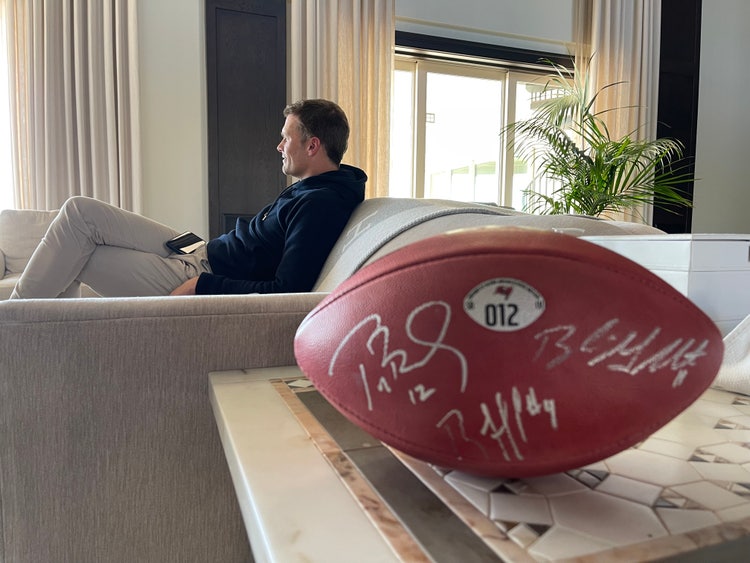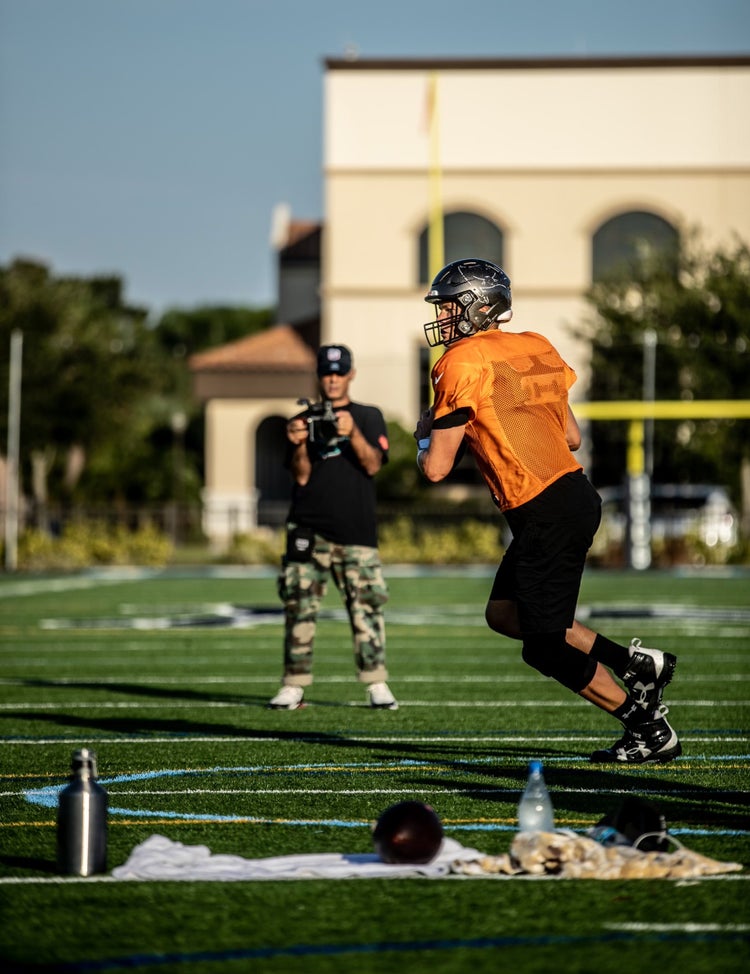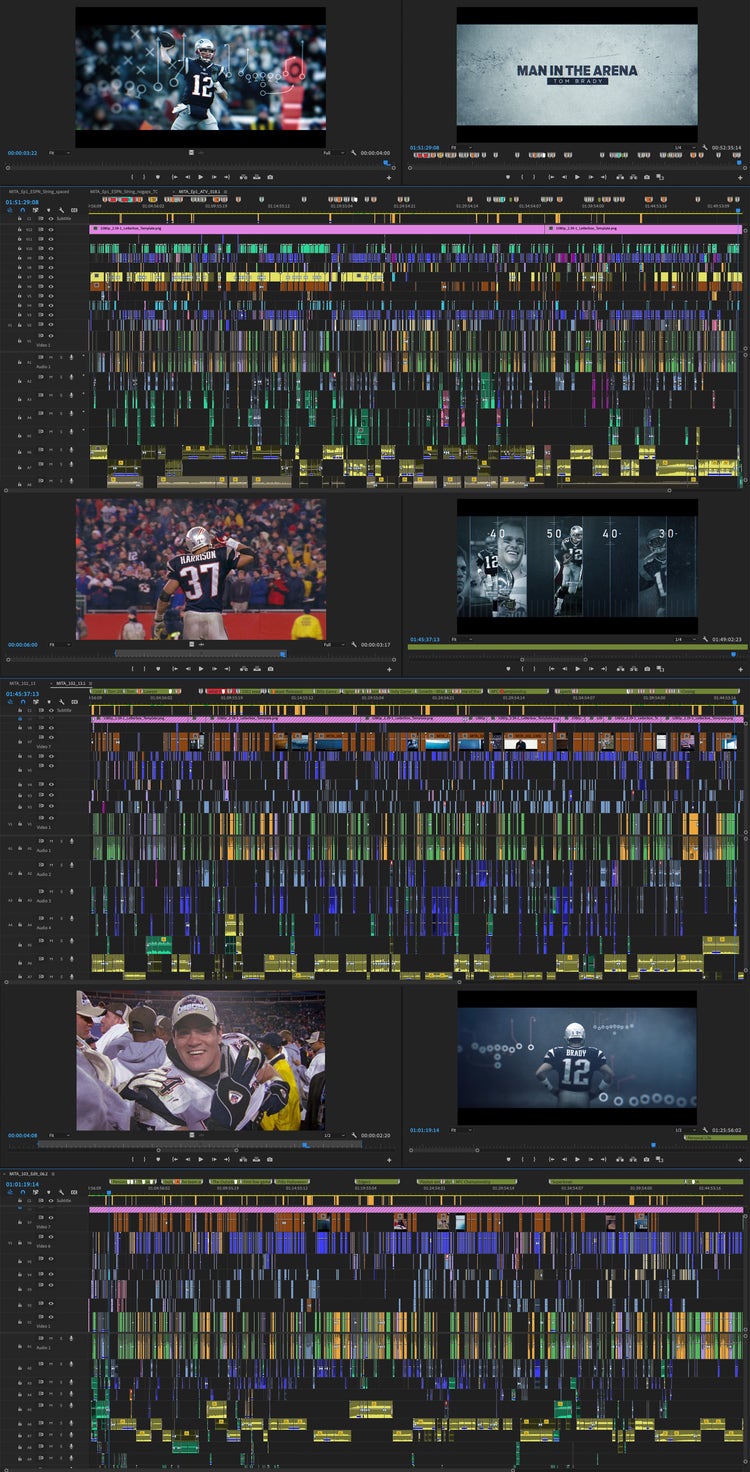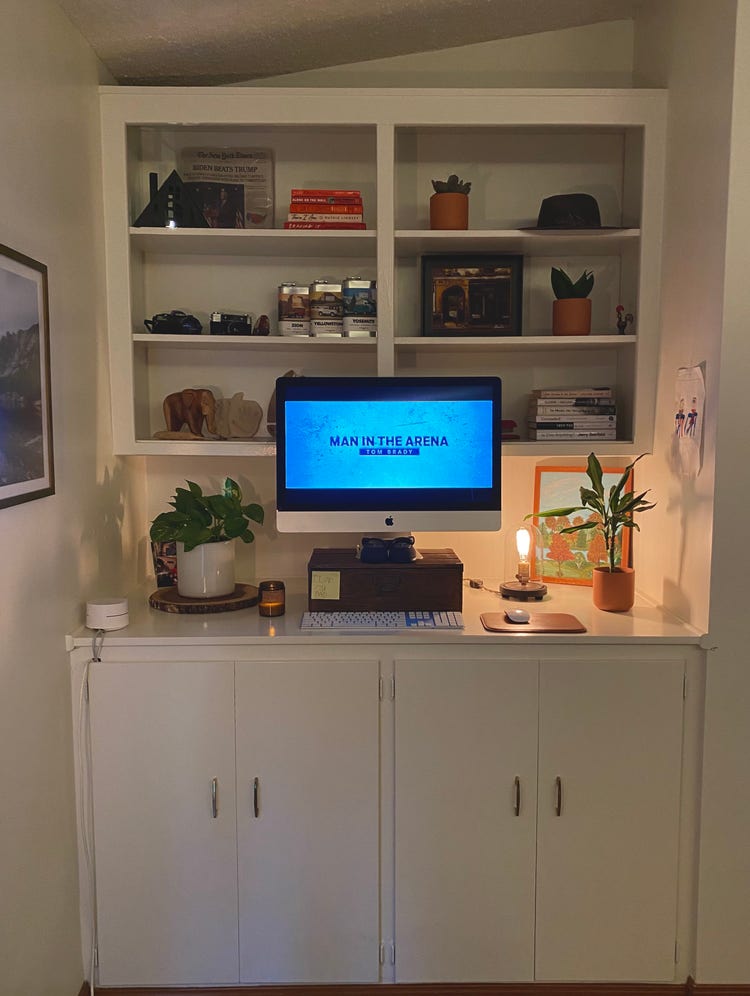The Stories behind Tom Brady’s Super Bowls

Image source: ESPN.
Man in the Arena: Tom Brady, from production company Religion of Sports, documents iconic moments from the legendary quarterback’s 20-year career in the NFL. Each episode deconstructs Brady’s Super Bowl appearances with firsthand accounts from the icon himself.
Alex Trudeau Viriato, who served as a co-producer and editor for the series, spoke with us about how he used Premiere Pro, including Productions, to chronologue Brady’s milestones. Alex is a nominee for Outstanding Editing — Long Form for his work on the series at the 43rd Annual Sports Emmy® Awards. Man in the Arena is also nominated for Outstanding Documentary Series at the Sports Emmy® Awards.
Read on below to find out how Alex got his start in editing and what drew him to the project — including what he and Brady have in common.
How and where did you first learn to edit?
When I was in high school I took the only film course offered, which had VHS decks I could edit with. That’s where I started making trailers for movies that I was into at the time — Heat and U-571. I’d also cut together family home videos, and later I would film with my friends on DV cam and edit those. Although, I would say that editing the subtext and story didn't happen until much later. Once I had committed my focus to being an editor after college, it took a lot of bad projects for me to hone in on what editing could accomplish.
How do you begin a project/set up your workspace?
I start by organizing and color coordinating. I’m a very visual person, so I like to see the edit represented with the colors of the interviewees or characters, archival, music and SFX. Once I have a good grasp on the project and the materials, I watch it all. Particularly in documentaries, I’ll watch everything before I start piecing anything together. I’ll write notes on paper along the way, possibly latch onto a few themes to explore, but it’s more about understanding the sandbox that you’re playing in. Before all of that, I call assistant editor Charles Farrell to make sure he’s available because he’s a grounding force in the editing process.
Tell us about a favorite scene or moment from this project and why it stands out to you.
Episode Seven. I was never a Patriots fan and most of what I knew about Tom Brady before this project was the headlines. I had been editing for a few months when I dove into episode seven. I was immediately connected to it and personally driven to tell that story. I spent hours investigating “deflategate,” and revisiting that incredible Super Bowl LI comeback. Although, what truly resonated with me was his sisters and his dialogue about family during those hard years. I could see the story in my head before I ever made a cut.
When you see Tom on the field, or in the spotlight, it can be hard to relate. In the moments of editing this episode I connected with him from the perspective of my own life experiences. I too am a husband to an extremely supportive wife, I too am a father of three, I too am a younger brother who wanted to be like his older sister, I too have very loving parents who taught me about family. All of these elements in life push us to be the best at something. Ultimately episode seven encapsulated why I joined this project almost two years ago.
Tom’s memory is something else that stands out. It’s incredible, he’ll remember the name of an obscure 3rd down play he ran against Miami in 2004 and what the weather was like. It blew my mind.

Image source: ESPN.
What were some specific post-production challenges you faced that were unique to your project? How did you go about solving them?
The project kept growing during the pandemic including the number of episodes, the length of the episodes and the amount of interviewees. I was brought in to edit the entire series, in an edit suite, at the office in March 2020. For months we kept operating as a small team, working remotely. I had rough cuts for four or five episodes before we regrouped and decided we would need editors working simultaneously on multiple episodes. I ended up cutting together story edits for all the episodes and then handing a few of those off to another editor. My biggest challenge was to be fully immersed in editing an episode, but then step away to supervise/collaborate with another editor on a different episode. It came down to time management and communication with the team. Knowing what episode needed my attention the most so that other people could be doing their jobs as well. After months of editing solo, we brought on Sean Hovarth. That was part of the solution, bringing on another strong editor that would bring fresh ideas and a creative mindset to continue to push the series forward. Another part of the solution was having a compassionate and supportive team of Meg Cirillo, Erik LeDrew and Gotham Chopra. They understood the creative challenge of having that many episodes happening at once.
What Adobe tools did you use on this project and why did you originally choose them? Why were they the best choice for this project?
We started this project right around the same time Productions was launching. It seemed like the obvious choice since it had the ability to keep all the episodes in a production but not bog down a single project with too much content. Having each episode in its own project helped keep everything organized and compartmentalized.
What do you like about Premiere Pro, and/or any of the other tools you used?
For me it’s always been about the look and movement within the timeline. So often I’ll throw pieces into a timeline and start moving them around to see what different moments and cadence I can create. In addition to that, whenever I use a different software I’m reminded how much I enjoy the simplicity and efficiency of the Premiere effects panel. I have so much control over the clips without adding extra effects or importing clips into another software. It’s seamless.
What’s your hidden gem/favorite workflow tip in Adobe Creative Cloud?
With this project in particular, I was working with a lot of preexisting NFL season recaps and Super Bowl videos for the rough cuts. So Scene Edit Detection became extremely useful. I don't always want to scrub through a sequence to find a clip. With Scene Edit Detection, I was able to see each individual shot in the bin, which goes back to being a visual person, it’s equally helpful to see all the individual shots represented in the timeline.

Image source: Alex Trudeau Viriato.
Who is your creative inspiration and why?
My creative inspiration has always been less about a particular person. There are so many individuals that I follow and who’s work stands out — Eddie Hamilton, Tom Cross, Jean-Marc Vallée and Marco Beltrami. Directors, writers, editors and composers. My inspiration comes from the emotions and conversations that arise during and after watching movies or documentaries. Before I ever paid any attention to who the editor was in the credits, I remember being inspired to create or tell stories that affected people the way I was after watching Good Will Hunting. I didn't grow up on the southside of Boston, nor did I have a rough upbringing or a hidden intellectual ability — but that movie had me reevaluating my own life circumstances, friendships and choices. When a movie causes me to reevaluate something in my own life, that’s when I’m inspired to do the same with my work. So often it’s not the same genre.
What’s the toughest thing you’ve had to face in your career and how did you overcome it? What advice do you have for aspiring filmmakers or content creators?
I was a couple years into my career, work was really slow as I was floating between assistant editor and editor on web content. I had just become a father and all my priorities were shifting. Not working had much larger consequences after my son was born. And at this point, I couldn't see myself doing anything else besides telling stories for a living. Sticking with my passion and pushing through some really slow months was the hardest thing I’ve had to do in my career.
My advice would be to talk to as many people in your profession as possible. Hear about their experience and what it’s like to do the job day in and day out. The ups and downs. How did they get there? When I was editing branded content, I met with multiple feature editors to learn and simply create relationships with people who had similar passions. Those didn't always lead to paying jobs or editing opportunities, but the perspective and knowledge was invaluable. Then you just keep pushing forward.
Share a photo of where you work. What’s your favorite thing about your workspace and why?
When I started this project, working from home was a struggle. Being so accessible to my family and hearing the everyday commotion throughout the house was hard to manage. I couldn't stay focused for large portions of time, or I’d lose my thought process on a scene because I could sense my help was needed with all three boys at home and one doing school via zoom. After a couple months I embraced how accessible I was, I started to thrive on the idea that I could have meals with my wife. That I could see my kids throughout the day and would make time for them whenever they popped their little heads in. I started to show them more of the work I did. “Dad, your job is to start and stop videos.” So my favorite part of my workspace is how close it puts me to my family. Distracting or not, it’s become something I appreciate and hope it doesn't change too much in the future.

Image source: Alex Trudeau Viriato.
Man in the Arena: Tom Brady is streaming weekly on ESPN+.